There was a lot more food then what the pictures shows! Anyway, we had a very good visit and I had to come baring a traditional gift for the family and I was so tickled to find out that the gift I had to buy for them is a gift box full of spam! Yes, I said SPAM! Apperently spam is huge here during the holiday seasons! So for you to learn more about this holiday I found some information to share with you!
Read the following information! Enjoy!
Chuseok (추석) is by far the biggest and most important holiday in Korea. It is a time when family members from near and far come together to share food and stories and to give thanks to their ancestors for the abundant harvest.
Chuseok is one of Korea’s three major holidays, along with Seollal (New Year’s Day) and Dano (the 5th day of the 5th month of the lunar year) and is also referred to as Hangawi (한가위), meaning “the ides of August” (August 15th according to the lunar calendar).
Hangawi/Chuseok was the day on which Koreans, an agrarian people throughout most of history, thanked their ancestors for the year’s harvest and shared their abundance with family and friends. Although the exact origin of Chuseok is unclear, the tradition can be traced back to ancient religious practices that centered around the significance of the moon. The sun’s presence was considered routine, but the full moon that came once a month, brightening the night sky, was considered a special and meaningful event. Therefore, harvest festivities took place on the day of the bright, full moon (Aug. 15 of the lunar year).
| On the morning of Chuseok Day, Songpyeon (a type of Korean rice cake) and food prepared with the year’s fresh harvest are set out to give thanks to ancestors through Charye (ancestor memorial service). After Charye, families visit their ancestors’ graves and engage in Beolcho, a ritual of clearing the weeds that may have grown up over the burial mound. After dusk, families and friends take walks and gaze at the beauty of the full harvest moon or play folk games such as Ganggangsullae (Korean circle dance). | ||||
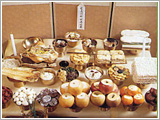 - Charye (ancestor memorial services) - Charye (ancestor memorial services)On Chuseok morning, family members gather at their homes to hold memorial services (called Charye, 차례) in honor of their ancestors. Formal Charye services are held twice a year: during Seollal (Lunar New Year’s Day) and Chuseok. The difference between the two services is that during Seollal the major representative food is white Tteokguk, a rice cake soup, while during Chuseok the major representative food is freshly harvested rice. After the service, family members sit down together at the table to enjoy delicious food that symbolizes their blessings. | ||||
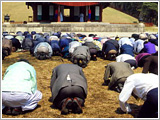 - Beolcho (clearing the weeds around the grave) and Seongmyo (visiting ancestral graves) - Beolcho (clearing the weeds around the grave) and Seongmyo (visiting ancestral graves)Visiting ancestral graves during Chuseok is known as Seongmyo (성묘). During this visit, family members remove the weeds that have grown around the graves in the summer season, a practice which is called Beolcho (벌초). This custom is considered a duty and expression of devotion and respect for one’s family. On the weekends, about one month prior to the Chuseok holidays, Korea’s highways become extremely congested with families visiting their ancestral graves to fulfill their familial duties. The graves are then visited again during Chuseok.
|


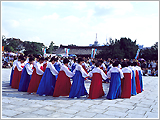 - Ganggangsullae (Korean circle dance)
- Ganggangsullae (Korean circle dance) 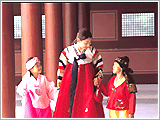 - Chuseokbim (Chuseok dress)
- Chuseokbim (Chuseok dress)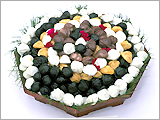 - Songpyeon
- Songpyeon
No comments:
Post a Comment